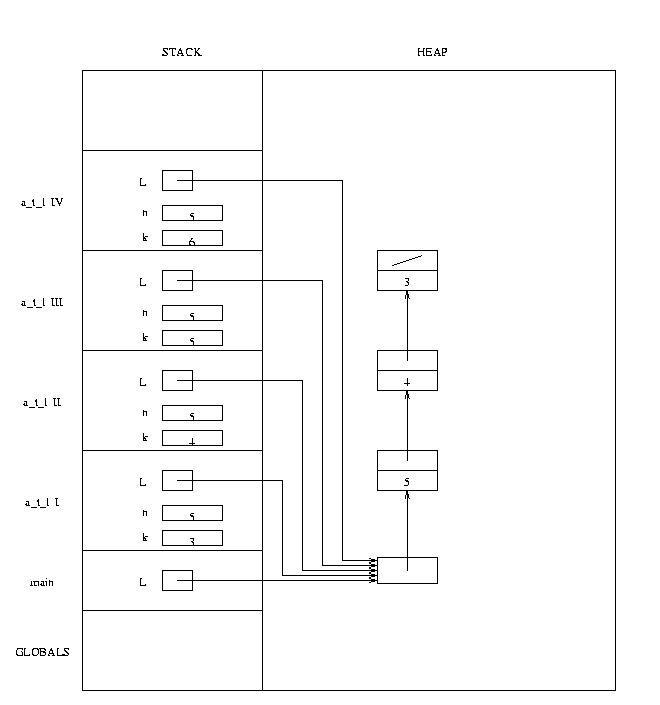Spring 2001, CSE 428: Solution of Final (2 May 2001)
Question 1
-
- 2 * 81 no
- 2 * (3 ^ 4) no
- (2 * 3 ^ 4) yes
- 2 * 3 * 4 yes
- There are two kinds of ambiguity:
- Associativity of ^
- Precedence between * and ^
An example of the first is:
Exp Exp
/|\ /|\
/ | \ / | \
Exp ^ Exp Exp ^ Exp
/|\ | | /|\
/ | \ | | / | \
Exp ^ Exp Num Num Exp ^ Exp
| | | | | |
| | | | | |
Num Num 4 2 Num Num
| | | |
| | | |
2 3 3 4
An example of the second is:
Exp Exp
/|\ /|\
/ | \ / | \
Exp * Num Exp ^ Exp
/|\ | | /|\
/ | \ | | / | \
Exp ^ Exp 4 Num Exp * Num
| | | | |
| | | | |
Num Num 2 Num 4
| | |
| | |
2 3 3
- An equivalent non-ambiguous grammar
where ^ has precedence over * is the following:
Exp ::= Exp * Num | Exp * A | B
A ::= Num ^ B
B ::= C ^ B | C
C ::= Num | (Exp)
Num ::= 0 | 1 | 2 | 3 | 4 | 5 | 6 | 7 | 8 | 9
An equivalent non-ambiguous grammar
where * has precedence over ^ is the following:
Exp ::= A ^ Exp | A
A ::= A * Num | Num | (Exp)
Num ::= 0 | 1 | 2 | 3 | 4 | 5 | 6 | 7 | 8 | 9
Question 2 (Memory management)

Question 3 (Concurrency in Java)
class Buffer {
private Information content;
private boolean empty;
public Buffer() { empty = true; }
public synchronized boolean is_empty() {
return empty;
}
public synchronized void put(Information i) { //we omit the treatment of interruptedExeption
while (!is_empty()) wait();
content = i;
empty = false;
notifyAll();
}
public synchronized Information get() {
while (is_empty()) wait();
empty = true;
notifyAll();
return content;
}
}
class Producer extends Thread {
private Buffer b;
...
public Producer(Buffer x){ b = x; }
public void run() {
...
b.put(info); // no need to test is_empty
...
}
}
class Consumer extends Thread {
private Buffer b;
...
public Consumer(Buffer x){ b = x; }
public void run() {
...
info = b.get();
...
}
}
Note that the wait() command is used in the methods
of Buffer, not in run(). It would make no sense
to use wait() in run() (and it would also
give a compilation error).
Question 4 (ML)
fun aux(leaf x, n) = leaf x
| aux(node(t1, x, t2), n) = node(aux(t1,n+1),n,aux(t2,n+1));
fun levels(t) = aux(t,1);
Question 5 (Prolog)
solutions(N,X,Y) :- nat(X,N), nat(Y,N), N is X + Y, factorial(Y,X).
nat(M,M) :- M >= 0.
nat(X,M) :- M > 0, N is M - 1, nat(X,N).
factorial(0,1).
factorial(Y,X) :- Y > 0, Z is Y - 1, factorial(Z,W), X is W * Y.
Question 6 (Prolog)
ord_merge(L,[],L).
ord_merge([],L,L).
ord_merge([X|L],[Y|M],[X|K]) :- X =< Y, ord_merge(L,[Y|M],K).
ord_merge([X|L],[Y|M],[Y|K]) :- X > Y, ord_merge([X|L],M,K).
